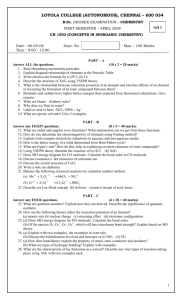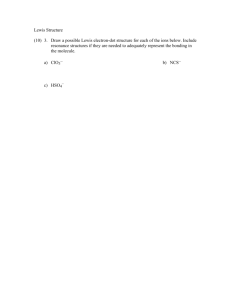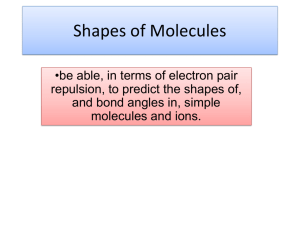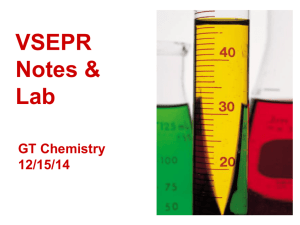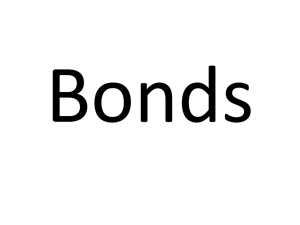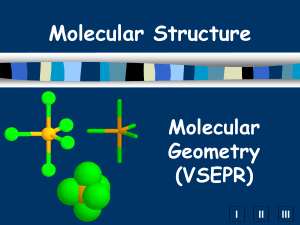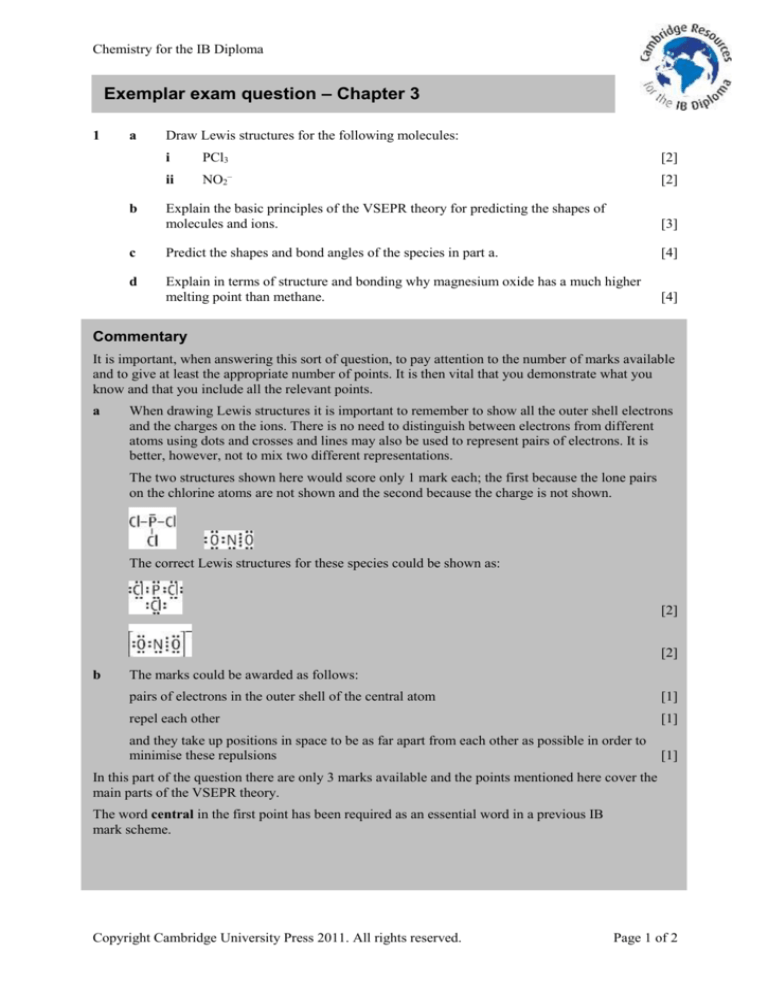
Chemistry for the IB Diploma
Exemplar exam question – Chapter 3
1
a
Draw Lewis structures for the following molecules:
i
ii
b
PCl3
NO2
[2]
–
[2]
Explain the basic principles of the VSEPR theory for predicting the shapes of
molecules and ions.
[3]
c
Predict the shapes and bond angles of the species in part a.
[4]
d
Explain in terms of structure and bonding why magnesium oxide has a much higher
melting point than methane.
[4]
Commentary
It is important, when answering this sort of question, to pay attention to the number of marks available
and to give at least the appropriate number of points. It is then vital that you demonstrate what you
know and that you include all the relevant points.
a
When drawing Lewis structures it is important to remember to show all the outer shell electrons
and the charges on the ions. There is no need to distinguish between electrons from different
atoms using dots and crosses and lines may also be used to represent pairs of electrons. It is
better, however, not to mix two different representations.
The two structures shown here would score only 1 mark each; the first because the lone pairs
on the chlorine atoms are not shown and the second because the charge is not shown.
The correct Lewis structures for these species could be shown as:
[2]
[2]
b
The marks could be awarded as follows:
pairs of electrons in the outer shell of the central atom
[1]
repel each other
[1]
and they take up positions in space to be as far apart from each other as possible in order to
minimise these repulsions
[1]
In this part of the question there are only 3 marks available and the points mentioned here cover the
main parts of the VSEPR theory.
The word central in the first point has been required as an essential word in a previous IB
mark scheme.
Copyright Cambridge University Press 2011. All rights reserved.
Page 1 of 2
Chemistry for the IB Diploma
c
The question asks you to predict the shape and bond angle. It is difficult to know how
much detail is required here. From the number of marks available it is probable that
there would be 1 mark for stating the shape and 1 for stating a bond angle. However, if in
doubt, it may be safer to also include some explanation (as long as that explanation is correct).
It is probably better to give either the name of the shape or draw a diagram, but if both are
given they must correspond to each other otherwise no marks will be awarded. For instance, the
answer shown below would score no marks for the shape as, although ‘trigonal pyramidal’ is
correct, the shape the diagram shows is a trigonal planar molecule:
trigonal pyramidal
A better response would be:
The shape is trigonal pyramidal as there are four negative charge centres around the P. [1]
The bond angle should be predicted to be slightly smaller than the tetrahedral bond angle and a
good answer would be:
107 as the lone pair repels bonding pairs more than they repel each other.
[1]
A bond angle in the range 100–108 would usually be accepted.
The answer for NO2– could be:
d
The shape is bent (V-shaped/angular) as there are three negative charge centres
around the N.
[1]
the bond angle could be about 118 as the lone pair repels bonding pairs more than
they repel each other.
[1]
The question states that an explanation must be in terms of structure and bonding so it is
usually best to start the answer with a description of these:
Magnesium oxide is an ionic compound that has a giant structure.
[1]
Methane is a covalent molecular compound.
[1]
The difference between the two boiling points can then be discussed:
When magnesium oxide is melted strong electrostatic forces of attraction between
the oppositely charged ions in the giant structure must be broken, which requires a
lot of energy.
[1]
When methane is melted only the weak van der Waals’ forces between molecules
must be broken, no covalent bonds are broken, and this does not require much energy. [1]
Copyright Cambridge University Press 2011. All rights reserved.
Page 2 of 2




